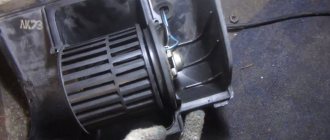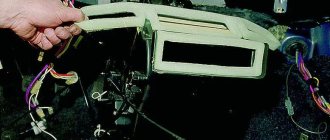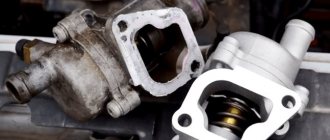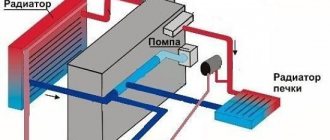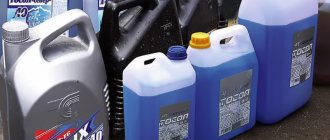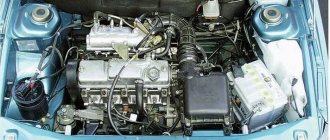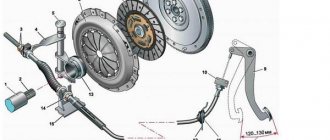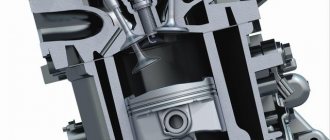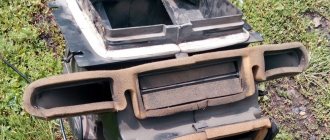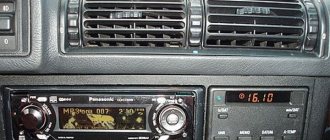The car's heating system must be in good working order regardless of the time of year. But many people think about this only when cold weather sets in. The efficient operation of the Lada Kalina heater ensures a comfortable stay in the cabin. The heating system does not fail so often, but timely maintenance is also important for it.
The design of the heating system Lada Kalina
The heater in a car transfers heat from the engine to the cabin. Without heating, the windows quickly fog up and become frosty in winter. On Kalina, the location of the stove allows for the possibility of integrating an air conditioner. The system is designed extremely simply and clearly, and is the same for models regardless of body type - station wagon, sedan or hatchback. It is shown schematically in the photo.
Heating system diagram
- The air duct exit is on the left.
- Air duct on the left.
- Windshield air ducts.
- Air duct distribution housing.
- Heater.
- Ventilation duct on the right.
- The air duct exit is on the right.
- Air duct for heating feet.
- Air duct for heating the interior.
- The air duct outlet is in the center.
The design uses the supply and exhaust circulation principle. Air enters the cabin, heated by the coolant, which simultaneously removes excess heat from the engine. The stove operates as a result of the radiator being heated by coolant. Then, with the help of a fan, the heated air flows through the air ducts through the deflectors into the car interior.
The heating system is controlled electronically. The volume of air masses that are heated from the heater radiator is regulated using a damper. On the center console there is an air conditioning control unit that controls the position of the damper and the speed of the electric fan.
The heater control unit consists of the following elements:
- Temperature regulator. By turning the knob, you can adjust the temperature of the air entering the cabin. Turning to the blue zone adds cold air, turning to the red zone adds hot air.
- Fan speed switch. It regulates the speed of air flow into the cabin.
- Air flow direction switch - to the windshield and down, only down to the feet, to the upper part of the cabin, to the windshield and side windows.
- Recirculation handle. Enables air circulation inside the cabin, while no air enters from outside. Can be used for a short time due to fogging of windows.
- Rear window defogger.
The control system also includes air duct deflectors. They can be closed or opened, and can also be used to regulate the direction of air flow.
A couple of useful tips
Have you noticed that the heater on the Lada Kalina blows cold? Proceed according to the scheme “from simple to complex”, first check the simplest elements of the heating and ventilation system, for example, the air filter and the presence of coolant. Then gradually move on to more complex design details.
Another good way to find out which part has failed is to replace it with a known working part and check the operation of the system. And you don’t have to buy a new spare part if you borrow it from a friend. You can also try to negotiate with the seller in the store, take a new part for testing, leaving a deposit.
Malfunctions of the Kalina heating system
The most common malfunctions of the stove are that the air flow is weak, only cold air comes in or not at all. Among the reasons why the stove on the Lada Kalina does not heat:
- Wear of the engine cooling system pipes. Antifreeze leakage due to worn hoses leads to a decrease in its level in the system, and therefore to insufficient heating of the heater radiator.
- The stove valve is out of order. This malfunction can be determined by the puddles of coolant that appear on the floor, under the front mats.
- The heating control unit is faulty. First, you should check the power supply from the on-board network. If it arrives, there is a problem in the air conditioning system. It is better to entrust unit repair to specialists.
- Wiring problems. There is no voltage supplied to the heating control unit. To check this, you will have to “ring” all sections of the chain.
- The additional resistor used to control the electric fan is faulty.
- The heater regulator is broken. In this case, it will be impossible to set a comfortable air temperature in the cabin.
- The radiator is faulty. One of the most common problems is that the Lada Kalina stove does not heat well. In the event of a breakdown, coolant leaks are typical. The part cannot be repaired.
If the problem is not heating, the cause is a malfunction of some part of the cooling system. These two systems are interconnected, and problems with one negatively affect the other.
Radiator
Every car has this element. In addition to the main one, a cabin radiator is also required. It is a little smaller, but the efficiency of the stove depends on its condition. So, this element may simply become clogged.
And both outside and inside. Most often, its insides become contaminated. This happens due to ignoring the regulations for replacing the coolant. Let us remind you that antifreeze is changed every 2 years or 60 thousand kilometers, and antifreeze - every 5 years or 150 thousand. If the liquid is not changed in time, it will lose its properties. The additives will no longer work and corrosion will form in the system. The liquid itself will contain characteristic flakes. They clog the small channels of the cooling system and heat exchangers.
The element may also become dirty from the outside. So, honeycombs often suffer from fluff and dry leaves. The way out of the situation is to externally wash the element. Performed on a removed radiator.
Determining a malfunction in the cooling system
The first sign that something is wrong with the cooling system is a decrease in the level of antifreeze in the expansion tank. The amount of coolant should be constantly monitored. In a working system, its level should be maintained between the minimum and maximum marks. If the amount of antifreeze begins to decrease, the engine will heat up faster and the risk of overheating will increase.
On Kalina there is no engine temperature indicator, there is only a light on the instrument panel that signals the critical temperature of the coolant. If you have to add antifreeze frequently, you should look for the leak. If the hoses are broken, they can be replaced, just like the clamps.
The next thing to check is the circulation of coolant in the system. After starting the engine, you need to pay attention to the expansion tank. Impaired circulation may be caused by a faulty water pump (cannot be repaired) or a clogged cooling system - in this case it needs to be cleaned.
To diagnose the thermostat, you need to start and warm the engine to 70-75 ° C, then touch the lower radiator pipe. If it is cold, the coolant circulates only through a small circuit due to the thermostat valve being stuck in the closed position. This device is replaceable only.
If after a full check the fault is not found, the cause of the stove malfunction is an air lock. After removing excess air, the heater’s operation returns to normal.
The stove does not heat up at idle: reasons and solution
Does the heater blow cold air at idle, and warm air at increased speeds? What is the reason and how to eliminate it. We will consider these and other questions in the article and give detailed answers. Not philosophically abstract. Accurate, because technology does not like understatement. Just something complicated.
Before we say the reason why in 90% of cases the stove does not heat up at idle , let's consider how the car's heating system works as a whole. A little. For understanding. How the stove works: main components, relationships
Structurally, the heating system consists of a radiator, pipes for circulating coolant (coolant, antifreeze), a flow regulator, air ducts, dampers and a fan. The process goes like this:
- pipes supply liquid to the radiator;
- then it circulates through the cooling and heating systems using a special pump;
- As soon as the engine starts to heat up, heat exchange occurs. Antifreeze takes the heat from the engine, cooling it and supplying a warm flow to the radiator, which heats up according to the principle of a regular (apartment) battery;
- at the same time, the stove fan drives cold air from the engine compartment through the radiator honeycombs, heating it;
- and again heat exchange occurs - the warm air flow enters the car interior, and the liquid enters the engine, cooling it. And so on in a circle.
This scheme is recognized as classic, the most common and effective. Used on most brands of cars. The temperature supplied to the inside of the car also depends on how well the heater radiator components function. A failure in one of the links leads, in particular, to the fact that the stove does not heat up at idle. And there are several reasons:
- Faulty engine pump.
- Insufficient coolant level.
- Airlock.
- Faulty coolant flow regulator (faucet).
- Clogged radiator.
And in 90% of cases, the radiator is to blame for the supply of cold air from the stove at idle. But more on this below, because the malfunction can also be affected by other components of the system.
Faulty pump
There are often explanations online that the stove only works while moving due to a poorly pumping pump. This statement is only partly correct. At idle, the rotation speed of the pump is low and, accordingly, the circulation of coolant is small. Low heat transfer results in low supply air temperature, which increases with increasing pump performance. More revolutions means the air heats up more.
What to do? Any problems associated with a malfunction of the pump (poor pumping, leaking, acting up, etc.) can be solved by replacing it. No one can give a 100% guarantee, because even with a fully operational pump, there is a possibility that the problem of cold air at idle will remain.
Insufficient coolant level
The stove does not heat up at idle due to a leaky cooling system: the radiator is leaking or the seal of the pipe connections is broken. This causes the antifreeze level to decrease, resulting in insufficient fluid reaching the radiator. And the heater blows cold. What to do? As a rule, adding antifreeze slightly above the set level and/or eliminating leaks and leaks will help solve the problem.
Airlock
The problem is due to a faulty conservator cap and insufficient coolant level. Factors affect the cooling system, in which excess air accumulates, creating an air lock. Due to insufficient circulation at low speeds, the stove blows cold. The air heats up when the speed increases, and when stopped it cools down again.
What to do? Eliminate the root cause: as in the case of system depressurization, add antifreeze, replace the expansion tank cap, bleed the system, blowing out excess air. You can remove the air by standing on an overpass so that the front wheels are higher than the rear wheels. Open the expander cover. At this moment, the air will come out accompanied by a characteristic sound (“gurgling”). Coolant will also leak, so it is important to top it up to the required level.
After this procedure, it is likely that after a while the air lock will form again. This is due to a blown cylinder head gasket. But in this case, the stove does not work well not only at idle.
Faulty coolant flow regulator (faucet)
Wear of the regulator leads to malfunctions in its functioning, that is, the faucet does not open completely. And at XX, there is not enough pressure to “squeeze” the hot liquid into the heater radiator, thereby supplying a warm air flow into the car interior. What to do? Replace the faucet.
Clogged radiator
Over time, scale forms in the radiator, which creates plugs. The obstruction of the lines leads to a decrease in the pressure that supplies warm air. At high speeds there may be an increase, but at idle you won’t get any warmth. What should I do? Theoretically, you can try flushing the radiator yourself. Many auto stores offer special mixtures that destroy salt compounds. But purging and flushing will only work if the lines are not completely clogged.
If there is no circulation in one of the pipes, then it will not be possible to flush it. Replacement only.
Advice may also include checking the thermostat, replacing the filter (if available), and the gasket. But in practice, the stove does not heat up at idle in 90% of cases precisely because of the high wear of the radiator . To avoid such problems, it is recommended to take preventive measures in time.
Use a high-quality cooling mixture, change it regularly, monitor the quality (after draining, for any impurities), do not mix several models of antifreeze.
Operate your car competently and enjoy a warm car in winter.
Source: https://rulikoleso.ru/interesnoe-na-jrepair-ru/agregats/ne-greet-pechka-na-kholostykh-oborotakh-prichiny-i-reshenie
Checking heating system elements
If the heater on the Lada Kalina does not work - it blows cold air - it is better to look for the reason, starting with the simplest thing. You should not immediately disassemble complex components. Typically, most problems arise from minor problems.
temperature sensor
If only hot or, conversely, only cold air blows from the air duct nozzles, regardless of the position of the damper, the cause of the malfunction is the interior temperature sensor. It is located in the ceiling, in the lampshade. The problem is solved by replacing the sensor.
Heating fan
If switching modes and air flow speed does not produce anything (a whistle or crackling sound is heard, the fan begins to make noise), the malfunction is related to the electric fan. To check this, you need to do the following:
- Set the temperature control knob to the extreme blue zone position.
- After that, use the switch to change the fan speeds from first to fourth.
The air flow should become stronger as speed increases. If this does not happen, then the fan is faulty. If it works, but not in all modes, or the speed changes disproportionately, then the cause of the breakdown is a failed auxiliary resistor. The source of the problem may be a blown fuse F5 in the mounting block due to an open circuit in the power supply.
Heater damper
To check the heater damper on the Lada Kalina, you need to set the temperature control knob to the extreme position in the blue zone, and the fan speed switch to “maximum”. Then you need to turn the damper control knob and at the same time monitor how the direction of air mass flow changes. If nothing happens, this indicates a malfunction of the damper regulator or the damper is stuck in one position (the traction cable has come off).
Why the stove doesn’t heat up on Kalina: reasons, ways to solve the problem
Often, car owners think about the serviceability of the stove only at the beginning of winter. But sometimes it can fail. Kalina is no exception. On it, like on many other Volga-made cars, the stove breaks down. For what reasons does this happen, and how to fix this problem? All this will be discussed further in our article.
Coolant
As you know, the cabin heater has its own radiator. It is filled with coolant. This design is part of the main cooling system. If the stove on the Lada Kalina does not heat well, the reasons may lie in the low level of antifreeze. Open the hood and check the level in the expansion tank. It should be between the minimum and maximum marks. Also, poor heat dissipation may be due to the presence of an air lock.
How to check it? With the engine cool, touch the upper and lower radiator hoses. They should not gurgle when squeezed. If this is the case, it means that air has formed in the system. He could have gotten there for various reasons. But in any case, you need to get rid of it. How to do it? It is necessary to drive the front of the car onto some hill and open the expansion tank cap. Next, start the engine and let it idle (with periodic gas revving up to two or three thousand) for a couple of minutes.
DIY heating system repair
To change this or that part of the heating system, it is not at all necessary to seek help from specialists. This will help save time, but not money. If you follow the recommendations, you can replace some system components yourself.
Heater fan
Even beginners can replace the Kalina stove fan. The main problem is its location. For this reason, most of the time is spent not replacing the part, but dismantling it.
Fan replacement with panel removal
The method is recommended by AvtoVAZ engineers, but it is not the simplest. Not everyone decides to use it in a regular garage. When performing work, you must follow the instructions:
- First, turn off the power to the on-board network by disconnecting the battery terminals.
- Drain all coolant and remove the cabin filter.
- After unscrewing the fastening nuts, lower the steering column to its lowest position.
- Release the brake light switch from the wires, unclip the clips, and remove the upholstery from the pillars.
- Unscrew the screws and remove the front panel (cladding), then remove the dashboard along with the deflectors.
- Now you can begin dismantling the fan. To do this, you need to disconnect the terminal with wires from it, remove the ventilation hose, and unscrew the fastening nuts.
After installing the new fan, all further actions are carried out in the reverse order of dismantling. The procedure requires attention and accuracy and takes a lot of time. At some points, the help of a second person will be required.
Replacing a fan without removing the panel
It is not practical to remove the entire dashboard just because of the heater fan. You can replace the device without removing the dashboard - you just need to lift its right side. Next, you should “arm yourself” with a knife and a flashlight and crawl under the panel. The noise insulation is cut off, the fasteners are unscrewed, and replacing the Kalina stove motor becomes much easier. This method will significantly save time and nerves, although it will create some inconvenience.
Before you start replacing the electric fan, you need to make sure that this particular device is faulty.
Replacing the temperature controller
To dismantle the part and replace it, it is necessary to remove the control unit assembly. The procedure looks like this:
- the on-board network is de-energized by removing the “negative” terminal from the battery;
- the radio tape recorder (if any) is removed, and the terminal block of wires is unhooked from it;
- the damper control lever is removed;
- Next, the handle for controlling the temperature and direction of air flow is dismantled;
- there are plugs located at the bottom of the control unit - they need to be removed and the fastening screws underneath must be unscrewed;
- the center console should be carefully pulled towards you;
- After removing the console, disconnect the terminal blocks from the switches.
After replacement, everything is assembled in the reverse order. This operation is simple and only requires a couple of different screwdrivers to get the job done.
Replacing the heater core without removing the panel
Changing the heater radiator on a Lada Kalina, as on all front-wheel drive VAZ cars, is not an easy task. You will have to remove most of the front panel. To work, you will need a new heater radiator, hoses, clamps, an angle grinder and a standard set of tools. First you need to carry out some manipulations in the engine compartment:
- drain antifreeze from the cooling system;
- remove the battery and air filter housing, ensuring unhindered access to the heater pipes;
- you need to disconnect all the rubber pipes from the stove in the engine compartment, unscrew the nut securing the metal shield that covers the hoses going to the stove into the cabin.
Now you need to go to the salon and perform the following steps:
- unscrew the three fastening nuts and remove the gas pedal;
- move the brake pedal as far as possible to the side;
- Having made a cut on the metal shield, cut off the radiator pipes with a knife;
- Unscrew the fastening screws and pull out the heater radiator towards the pedals.
Removing the radiator without removing the panel is only half the battle. It is no less problematic to install it. Before this, the pipes should be thoroughly cleaned of burrs and roughness with fine-grained sandpaper.
A hose with a thicker end is attached to the upper radiator outlet, and a narrower end to the lower outlet. The other ends, without being confused, need to be installed instead of the old ones. It is advisable to treat the place where the hoses from the passenger compartment enter the engine compartment with soundproofing material.
Replacing the stove radiator will help solve the problem of insufficient heating. Due to the labor-intensive nature of most work on troubleshooting a heating system, prices for such services at specialized service stations may seem quite high. It is not surprising that many “folk” repair methods have appeared.
Heating system modifications
Every owner of a Lada Kalina is faced with the need to modify the stove. The upgrade usually involves installing a new 6-hole thermostat, a coolant filter element, and a different heater valve. Many, given the mediocre performance of the pump, install an additional water pump. There are many ways of minor tuning that can be used to achieve improvements for greater comfort.
Increase in operating temperature
This method is suitable for Lada Kalina with an electronic gas pedal. Previously, the throttle valve, which was heated by a common cooling system, was controlled by a cable drive. After installing the electronics, the hose that went for heating was looped into the cooling system.
To upgrade, you will need a tee, an additional hose and clamps. The second air duct is mounted as close as possible to the thermostat - the tee is installed in the coolant supply pipe to the radiator. The other end of the air duct is connected to the outlet of excess steam near the expansion tank fitting. Thanks to such a simple modernization, it is possible to increase the operating temperature to 92-95 ° C when the stove warms up from 50 ° C and above.
Installation of a hydraulic fence for drainage
A regular medical dropper is inserted into the channel of the steam outlet tube, which is immersed in antifreeze to the bottom of the expansion tank. As the liquid cools, obeying the law of physics about communicating vessels, it will begin to be drawn into the steam outlet, preventing the possible formation of air plugs - airing. Thanks to this simple method, the stove will begin to heat much more efficiently, which means the interior will be warmer.
You can also change the clamps to more reliable ones - self-tightening ones, and ordinary rubber hoses - to silicone ones. To reduce heat losses, it is worth taping all the joints of the air ducts, but to do this you will have to dismantle the panel again. The most convenient way to do this is when troubleshooting a problem.
Regular removal and installation of the dashboard will lead to its loosening, squeaks, knocks and other extraneous sounds will appear coming from under the panel while driving.
